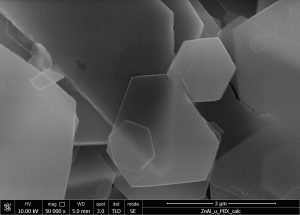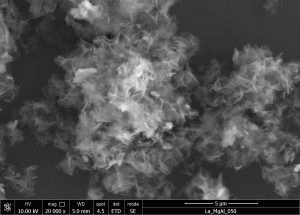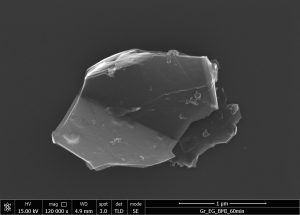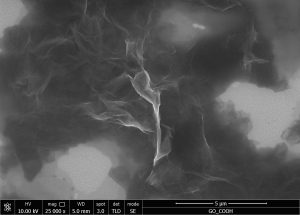Contact person: Petra Ecorchard
A focus of the research is on 2D structures, especially carbon-based materials prepared from various sources. Typical representatives are graphene, graphene oxide and their derivatives obtained by functionalization. Graphene and its analogues are prepared mainly by exfoliation in a batch high-performance ultrasound reactor (2kW) under high pressure (~ 5 bar). The development of 2D materials have spread to layered double hydroxides (LDH). Interaction of LDH with ionic liquids (IL) was investigated and applied in polymer matrices in cooperation with the Institute of Macromolecular Chemistry, Czech Academy of Sciences (IMC). Modifications of carbon- based materials as well as LDH were investigated for applications as polymer fillers; suitable fillers are chosen depending on the desired properties of the final polymer. It also determines the selection of suitable IL depending on the particular type of the filler and the kind of intended polymerization process. IL serves as intercalation agent for these layered fillers as well as a means of enabling both physical and chemical bonds. Methods of preparation of 2D fillers and their stabilization before the subsequent agglomeration are the subject of further research.
2D materials based on carbon can be advantageously applied in biology, for example as carriers. In this area, the research of these materials is still open.
Contact person: Snejana Bakardjieva
The other research area of 2D materials is known as 2D MXenes. MXenes are a new family of 2D early transition metal carbides or nitrides obtained by selective etching of the elements in the corresponding MAX phases or by Low Energy Ion Facility – an unconventional method utilizing sputtering of individual phase elements by low energy beam of noble gas prepared in an electrostatic accelerator. MXenes offer a large number of chemical compositions compared with graphene, limited to just carbon atom. MXenes may have a wide range of application – nanolaminates for nuclear and extreme environmental conditions, energy storage, polymer nanocomposite filers.
References
Ondřej Mrózek*, Melounová Lucie, Smržová Darina, Machálková Aneta, Vinklárek Jaromír, Němečková Zuzana, Komárková Bára, Ecorchard Petra, „Salt-washed graphene oxide and its cytotoxicity“, J. Hazard. Mater. 398 (2020) 123114, DOI:https://doi.org/10.1016/j.jhazmat.2020.123114 IF = 9.038.
Horak P*., Bakardjieva S., Vacik J., Ruic X., Klie R., „Preparation of Ti2C MXene phase by ion beam sputtering and ion irradiation“, Nuclear Inst. and Methods in Physics Research B 468 (2020) 49-51, DOI:https://doi.org/10.1016/j.nimb.2020.02.010 IF = 1.27
Ondřej Mrózek, Petra Ecorchard*, Petr Vomáčka, Jakub Ederer, Darina Smržová, Michaela Šrámová Slušná, Aneta Machálková, Martina Nevoralová, Hynek Beneš, „Mg-Al-La LDH-MnFe2O4 hybrid material for facile removal of anionic dyes from aqueous solutions“, Appl. Clay Sci., 169 (2019) 1–9, DOI: https://doi.org/10.1016/j.clay.2018.12.018, IF = 3.641, Q2.
Anna P. Godoy, Petra Ecorchard, Hynek Beneš, Jakub Tolasz, Darina Smržová, Leandro Seixas, Jairo J. Pedrotti, Eunezio A.T. de Souza, Omar A. El Seoud, Ricardo K. Donato*, „Ultrasound exfoliation of graphite in biphasic liquid systems containing ionic liquids: a study on the conditions for obtaining large few-layers graphene“, Ultrason. Sonochem., 55 (2019), 279-288, DOI: https://doi.org/10.1016/j.ultsonch.2019.01.016, IF = 6.012, Q1.
Dana Schwarz, Yu Noda, Jan Klouda, Karolina Schwarzová-Pecková, Ján Tarábek, Jiří Rybáček, Jiří Janoušek, Frank Simon, Maksym V. Opanasenko, Jiří Čejka, Amitava Acharjya, Johannes Schmidt, Sören Selve, Valentin Reiter-Scherer, Nikolai Severin, Jürgen P. Rabe, Petra Ecorchard, Junjie He, Miroslav Polozij, Petr Nachtigall, and Michael J. Bojdys*, „Twinned Growth of Metal-Free, Triazine-Based Photocatalyst Films as Mixed-Dimensional (2D/3D) van der Waals Heterostructures“, Adv. Mater., 29 (40) (2017), 1703399 (1-9), DOI: 10.1002/adma.201703399, IF = 19.791, Q1.
Gallery

SEM figure of annealed Zn-Al LDH (450 °C)

SEM figure of Mg-Al-La LDH-MnFe2O4

SEM figure of graphite after exfoliation with ionic liquid in ethylene glycol

TEM image of carboxylated graphene oxide